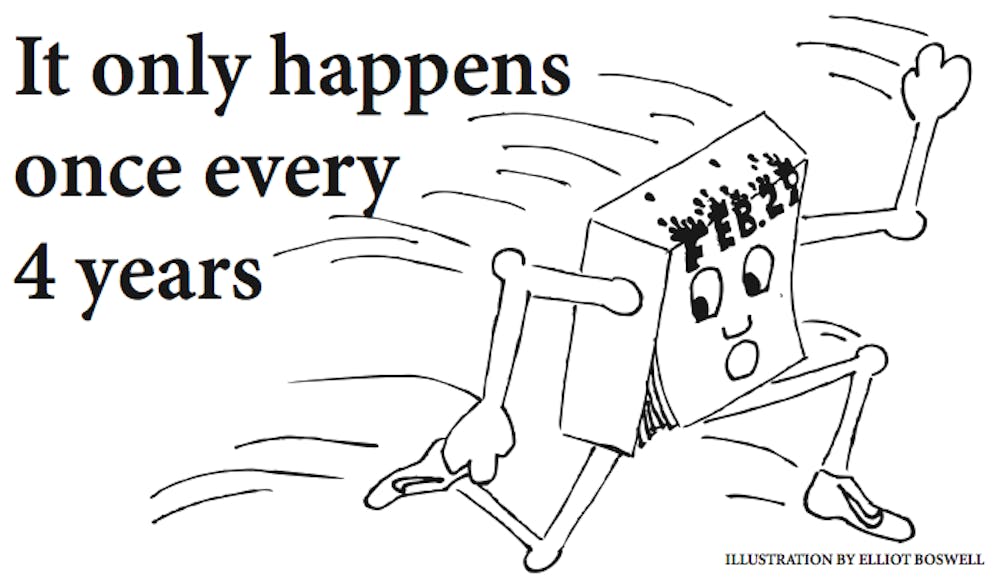(Elliot Boswell)
By Aziz Inan
Friday, Feb. 29, 2008, the second leap day of the 21st century, is at our doorstep reminding us that not only four years passed since the last leap day, but we will have to wait four more years for the next one to arrive. We will use this occasion to cover some facts related to leap days.
Question: Unlike the last century, which had 25 leap days (the 25th being Tuesday, Feb. 29, 2000), the 21st century has only 24 leap days. Why?
Answer: In the Gregorian calendar (which is the current standard calendar adapted by a large percentage of the countries in the world), the duration of one year approximately corresponds to the duration of a solar year. A solar year is the time it takes for the Earth to complete one full orbit around the Sun, which is nearly equal to 365¼ days.
There are two types of years in the Gregorian calendar, a common year having 365 days total whereas the month of February has only 28 days, and a leap year having 366 days total where February has an extra leap day, February 29.
Most years that are divisible by four are leap years meaning that leap year occurs once every four years. Adding an extra leap day to the calendar once every four years compensates for the fact that a solar year is close to 365 1/4 days, that is, 1/4 day more than 365 days.
So, in four years, the extra 1/4 days add up to an extra day which is the reason why the leap year with 366 days was introduced into the Gregorian calendar. Having a leap day every four years synchronizes the calendar with the solar year.
However, some exceptions to this rule apply since the duration of a solar year is actually slightly less than 365 1/4 days. More accurately, the duration of a solar year is close to 365.2425 days (or 365 days, five hours, 49 minutes and 12 seconds). On this basis, even with a leap day every four years, the calendar still goes out of sync with the solar year, getting ahead of it by about 10 minutes and 48 seconds every year.
Over the course of 400 years, this shift accumulates to three days. To account for this three-day shift, in 400 calendar years, there is only need for 97 leap days instead of 100. For this reason, the leap year is omitted from the calendar three times every 400 years.
To achieve the goal of having only 97 leap years over 400 years, it's decided that a century year divisible by 100 but not divisible by 400 should not be a leap year. That is, leap years are all years that are divisible by four, with the exception of those years that are divisible by 100 but not by 400. For example, the century year 2000 is a leap year because it's divisible by 400. However, the century years 2100, 2200 and 2300 are not leap years because they are not divisible by 400. Century year 2400 is a leap year because it's divisible by 400.
Question: What would happen if all the leap days in the calendar are cancelled?
Answer: Then, every February would have 28 days and every year would consist of 365 days. The extra 1/4 day in each solar year would start adding up and as a result, the calendar would start falling behind the solar year by about one day every four years.
Over the course of a century, the difference between the solar year and the calendar would become 25 days. After 120 years, the seasons would shift backwards by approximately one month. In 360 years, all the seasons would shift backwards by three months - summer would occur in spring (i.e., the months of March, April and May would become summer months), spring would occur in winter, winter in fall and fall in summer.
Future generations would celebrate Halloween with no hay stacks and pumpkins. If Christmas is in summer, Santa and his reindeer would end up not only wearing T-shirts and shorts in the hot summer but they would also need to carry a lot of drinking water with them.
They also would need to replace their traditional sled with a different type of vehicle to transport their Christmas gifts. Independence Day (Fourth of July) would be celebrated indoors in the winter time because not only would there be freezing temperatures outside, but also the firecrackers would get so wet on snow-covered grounds that they wouldn't light up. I guess the list can go on.
Question: What is the chance of being born on a leap day (that is, being a leap day baby)?
Answer: Since there are 97 leap days over a period of 400 years (which is 146,097 days), assuming all birthdays are distributed equally throughout the calendar, the chance of a person being born on a leap day is given by 97/146,097, which is approximately equal to 1/1,506.15, or 0.000663942, or 0.0663942 percent. This is close to one out of 1,500 people which is indeed a very low possibility.
Based on this probability value, for example, there are only two or three leap day babies on the entire University of Portland campus since it has currently a total population somewhere between 4,100 and 4,200 people.
The city of Portland, with a population of around 600,000 people, probably has close to 400 leap day babies total. The State of Oregon, with a population of about 3.7 million, has somewhere between 2,400 to 2,500 leap day babies. The United States, with a population that recently exceeded 300 million people, has about 200,000 leap day babies. China, with a population of at least 1.3 billion, has close to 900,000 leap day babies. The total number of leap day babies over the whole world is close to 4.5 million based on the fact that the world population is currently about 6.65 billion.
Question: Are there any other interesting facts about the leap day?
Answer: Yes, many, but you just have to wait another four years to find out about them. Right now, don't waste any time, go out and enjoy your leap day of 2008 before it's over.
Aziz Inan, Ph.D., is a professor of electrical engineering and computer science








